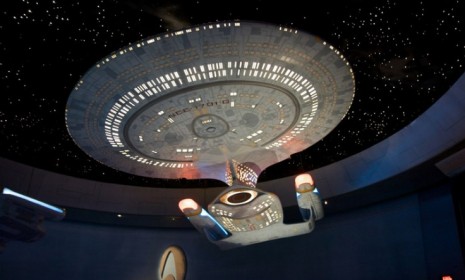The ambitious plan to build Star Trek's USS Enterprise
One adventurous engineer makes a compelling case to boldly build what no man has built before. Could the crazy thing actually work?

If Elon Musk's space exploration company SpaceX is any indication, the future of space travel is in the hands of people with big imaginations. And nobody's vision is quite as ambitious as one engineer who has outlined an elaborate plan to build Star Trek's USS Enterprise, which he says could be ready to fly within the next 20 years. "We have the technological reach to build the first generation of the spaceship... so let's do it," writes BTE Dan on his website, BuildTheEnterprise.org (which has been loading intermittently because of heavy traffic). The website includes conceptual blueprints, budgeting proposals, a timeline for research and development, and almost every other conceivable detail, raising the question: Could BTE Dan actually pull this crazy thing off? Here's what you should know about the engineer's sprawling vision:
Who is this guy?
He hasn't responded to any media queries, but BTE Dan (shorthand for "Build the Enterprise") says he is a systems and electrical engineer who has worked for a Fortune 500 company for the past 30 years. Little else is known about him — other than that he is a Star Trek fan and very, very thorough.
The Week
Escape your echo chamber. Get the facts behind the news, plus analysis from multiple perspectives.

Sign up for The Week's Free Newsletters
From our morning news briefing to a weekly Good News Newsletter, get the best of The Week delivered directly to your inbox.
From our morning news briefing to a weekly Good News Newsletter, get the best of The Week delivered directly to your inbox.
What's his plan?
He wants to build a fully working version of the iconic spacecraft by the year 2032. The proposal calls for a "full-sized, ion-powered version of the Enterprise complete with 1G of gravity on board," says Universe Today. The "Gen1," while not quite up to par with the fictional version envisioned for the year 2245 by Star Trek creator Gene Roddenberry, would utilize next-generation technologies already available today. The craft could pull triple duty as a spaceship, space station, and spaceport, capable of fitting thousands of space-goers onboard at a time for a configuration that's "quite functional," writes BTE Dan.
How would the starship work?
The Gen1 would run on nuclear power, and keep travelers' feet planted to the ground using a constantly rotating gravity-wheel to generate 1G of gravitational force. (Watch a demonstration of the concept below.) Three additional nuclear reactors would supply auxiliary power for things like lasers, which would allow the craft to sear through a prospective moon's icy crust and plop down safely in its oceans. The ship would be assembled in space, stretching 3,150 feet from front to back — that's longer than the height of two Empire State Buildings.
A free daily email with the biggest news stories of the day – and the best features from TheWeek.com
Could it zoom through space at warp speed?
Unfortunately, the ship "won't cruise the galaxy at light speed," says Popular Science, but it would allow us easy access to "new worlds right in our own neighborhood," namely Mars (which the ship would be able to zip to in just 90 days thanks to its ion-powered engines), Venus, and possibly Jupiter's ice-covered moon, Europa. BTE Dan envisions the USS Enterprise hopping "from planet to planet, dropping off robotic probes of all sorts en masse — rovers, special-built planes, and satellites."
Who would fund this?
The big if for the plan — with big being an understatement — "would be getting Congress to provide NASA the funding to do a huge 20-year project," says Universe Today, with estimates tallying close to $1 trillion. But BTE Dan has already done the math. His budget proposal includes tax increases and budget cuts to areas like discretionary spending and housing and urban development. These changes would "barely be noticed," he argues. In fact, according to his plan, a new USS Enterprise could be developed every 33 years, giving each new generation a starship of its own.
This sounds cool, but is it even worth entertaining?
"We need a far grander vision of what we should be doing to get humans up into space," says BTE Dan. "If we are going to ask taxpayers to pay billions of dollars for projects to put Americans into space, it should be for an idea that they can relate to and be inspired by." But "building directly from science fiction is not necessarily a good idea," says The Verge. Well I, for one, think we ought to "Make. It. So," says Jill Pantozzi at The Mary Sue. "We should not be done going boldly where no one has gone before."
Sources: The Mary Sue, Popular Science, The Verge, Universe Today
-
 5 fairly vain cartoons about Vanity Fair’s interviews with Susie Wiles
5 fairly vain cartoons about Vanity Fair’s interviews with Susie WilesCartoon Artists take on demolition derby, alcoholic personality, and more
-
 Joanna Trollope: novelist who had a No. 1 bestseller with The Rector’s Wife
Joanna Trollope: novelist who had a No. 1 bestseller with The Rector’s WifeIn the Spotlight Trollope found fame with intelligent novels about the dramas and dilemmas of modern women
-
 Codeword: December 20, 2025
Codeword: December 20, 2025The daily codeword puzzle from The Week